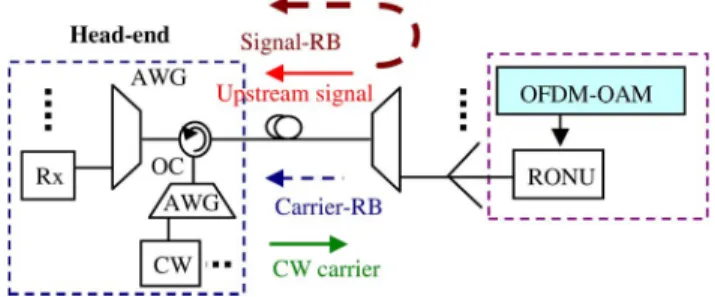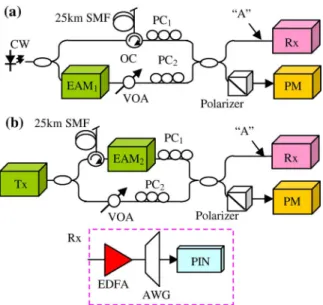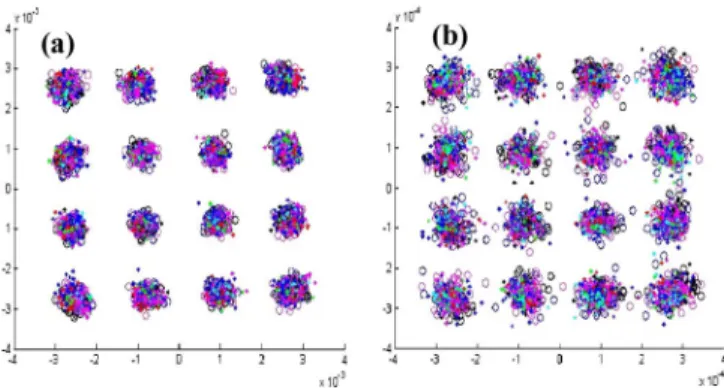1848 IEEE PHOTONICS TECHNOLOGY LETTERS, VOL. 20, NO. 22, NOVEMBER 15, 2008
Rayleigh Backscattering Performance of
OFDM-QAM in Carrier Distributed Passive
Optical Networks
C. W. Chow, Member, IEEE, C. H. Yeh, C. H. Wang, F. Y. Shih, and S. Chi
Abstract—The passive optical network (PON) using an
or-thogonal frequency-division-multiplexing (OFDM) format is a subject of many research works recently. Due to the high spectral efficiency, low bandwidth optical components can be used in this OFDM-PON. We quantify, for the first time, the performance of the OFDM signal when subjected to the noise generated by the two components of the Rayleigh backscattering (RB): carrier generated RB (carrier-RB) and signal generated RB (signal-RB) that are present in the carrier-distributed PONs. An RB com-parison between OFDM quadrature amplitude modulation and nonreturn-to-zero is preformed.
Index Terms—Orthogonal frequency-division multiplexing (OFDM), passive optical networks (PONs), Rayleigh backscat-tering (RB).
I. INTRODUCTION
D
ISTRIBUTED reflections along the silica optical fiber caused by random index fluctuations result in Rayleigh backscattering (RB) [1]. This process is considered as one of the major impairments in bidirectional systems, Raman ampli-fication, and passive optical networks (PONs) [2], [3]. When optical amplification is present, the additional noise power due to amplified spontaneous emission (ASE) will further degrade the received signal. The RB noise is partially polarized in na-ture, with a colored power spectral density (PSD) proportional to the PSD of the generating input signal. This is different from the ASE, which is typically assumed to be a white noise. Because of the unique features of the RB, by using proper network architecture and using advanced modulation formats [3]–[5], RB-induced signal degradation can be mitigated. This is particularly true for PON using centralized carrier distribution. Dense wavelength-division-multiplexed (DWDM) PONs employing centralized optical carrier distribution and wavelength-insensitive (colorless) reflective optical networking units (RONUs) are attractive since the wavelength referencingManuscript received June 05, 2008; revised August 03, 2008. Current version published October 31, 2008. This work was supported by the National Science Council, Taiwan, R.O.C., under Contract NSC 96-2218-E-009-025-MY2 and Contract 97-2221-E-009-038-MY3.
C. W. Chow, C. H. Wang, F. Y. Shih, and S. Chi are with the De-partment of Photonics, National Chiao Tung University, Hsinchu 30010, Taiwan (e-mail: cwchow@faculty.nctu.edu.tw; shoutclose@gmail.com; yuan0253@hotmail.com).
C. H. Yeh is with the Information and Communications Research Laborato-ries, Industrial Technology Research Institute, Hsinchu 31040, Taiwan (e-mail: depew@itri.org.tw).
Color versions of one or more of the figures in this letter are available online at http://ieeexplore.ieee.org.
Digital Object Identifier 10.1109/LPT.2008.2004351
Fig. 1. Schematic of DWDM-PON. AWG: arrayed waveguide grating; OC: op-tical circulator; Carrier-RB and signal-RB: carrier and signal generated RB. Inset: upstream PM-NRZ signal.
and control are provided in the head-end office. Wavelength tunable sources are not required at the cost-sensitive ONUs. Cost can be further reduced since the same optical components can be used for all the ONUs; and a single laser source can be shared by all the ONUs in a given time-division-multiplexed (TDM) PON if the hybrid DWDM-TDM-PON is used [2].
Recently, PON using orthogonal frequency-division mul-tiplexing (OFDM) is a subject of many research works [6], [7]. Due to the high spectral efficiency of the M-quadrature amplitude modulation (QAM) used in the OFDM signal, low bandwidth optical components can be used. Additionally, the inherent advantage of OFDM frequency diversity transmission enables simple equalization of frequency response by baseband digital signal processing (DSP). The OFDM signal has a high tolerance to chromatic dispersion. This high tolerance is es-pecially useful in PONs since distances between the head-end office and different ONUs cannot be fully dispersion-com-pensated. Furthermore, it offers the prospect of integrating forward error correction to improve transmission. However, previous works show that carrier-distributed OFDM-PON suffers form interferometric beat noise generated by RB [7]. Here, we quantify, for the first time, the performance of the OFDM-QAM signal when subjected to the noise generated by the two different components of RB that are present in the carrier-distributed OFDM-PON.
II. EXPERIMENT
Fig. 1 shows the simplified architecture of the carrier-distributed OFDM-PON. The continuous-wave (CW) carrier sent from the head-end office will be used as a seed wavelength to the colorless RONU to generate the upstream signal. The RONU could be an electroabsorption modulator (EAM), or a reflective semiconductor optical amplifier. In these PONs, there
CHOW et al.: RB PERFORMANCE OF OFDM-QAM IN CARRIER DISTRIBUTED PONs 1849
Fig. 2. Experimental setup to emulate (a) carrier-RB and (b) signal-RB. VOA: variable optical attenuator; PC: polarization controller; PM: power meter. Inset: Rx architecture; AWG: arrayed waveguide grating.
are two contributions to the RB which interfere with the up-stream signal at the head-end receiver (Rx), as shown in Fig. 1. Carrier-RB is generated by the CW carrier being delivered to the RONU. At the upstream Rx, the carrier-RB will beat with the upstream signal to produce interferometric noise. Signal-RB is generated by the modulated upstream signal output from the RONU which is then backscattered towards the RONU where it is remodulated and reflected upstream towards the Rx. The relative impact of the two components depends on the network configuration and hence separate analysis is required.
Fig. 2(a) and (b) shows the experimental setups used to an-alyze and quantify the RB tolerance of the OFDM-QAM up-stream signal, which emulated the impairments of a real PON by generating two interfering signals in the upper and lower arms of the interferometer. For carrier-RB analysis [Fig. 2(a)], the CW signal (wavelength 1548 nm, output power 6 dBm, laser linewidth 10 MHz) was split by a 3-dB fiber coupler between two output paths. The carrier-RB was generated in the upper path using a 25-km standard single-mode fiber (SMF) termi-nated with a low reflection, angled connector. It was extracted via a circulator. In the lower path, the remainder of the CW was modulated by EAM to produce the signal. A variable tical attenuator varied the signal power to generate different op-tical signal-to-Rayleigh-noise ratios (OSRNRs), which is de-fined as the ratio of total signal and total RB power at the input to the head-end (point “A”). The carrier-RB and signal were then copolarized (highest noise case) using polarization controllers PC and PC , before being combined in the fiber coupler. They were monitored by using the polarizer and the power meter (PM) at the other output port of the coupler. Both the signal and carrier-RB were then launched into an optically preamplified Rx (inset of Fig. 2) formed by an erbium-doped fiber amplifier (EDFA), a Gaussian-shaped arrayed waveguide grating (AWG) (3-dB width of 50 GHz), and a PIN photodiode (bandwidth of 4 GHz). In the signal-RB analysis [Fig. 2(b)], the remodulated backscattering was generated by first modulating the optical signal at the transmitter (Tx) [using a directly modulated dis-tributed-feedback laser diode with proper bias for OFDM signal,
Fig. 3. Measured RF spectrum of the 4-Gb/s OFDM-QAM signal, occupying 1-GHz bandwidth.B : frequency gap.
and using CW with another EAM for nonreturn-to-zero (NRZ) signal generation (extinction ratio of 10 dB)]. The remodula-tion of the backscattered signal occurring in real network was then emulated by EAM . The signal from the lower arm and the signal-RB from the upper arm were combined by a fiber coupler and then launched into the Rx.
The OFDM signal was generated through a DSP and a dig-ital-to-analog converter (DAC), as described in [6], which is an arbitrary waveform generator with 4-GHz sampling rate. The incoming bit streams were packed into 16 subcarrier symbols; each subcarrier symbol was a 16-QAM format. With inverse fast Fourier transform (IFFT), these subcarrier symbols were con-verted to a real-valued time-domain waveform, called an OFDM symbol. The signal was applied to EAM for the carrier-RB analysis and to Tx and EAM for the signal-RB analysis, respec-tively. The OFDM signal was directly detected. An analog-to-digital converter (ADC), connected to the Rx, converted the OFDM signal detected to digital signal for demodulation. Syn-chronization of extracted carrier phase and fast Fourier trans-form (FFT) for time to frequency-domain translation was per-formed. Then the QAM decoder analyzed the symbol on each subcarrier. The 1G symbol/s OFDM signal occupied the spec-trum from 62.5 MHz to 1125 MHz with a data pattern consisting of 8192 OFDM symbols. The bit-error rate (BER) was calcu-lated from the measured error vector magnitude (EVM) [8]. The carrier-RB and signal-RB of 4-Gb/s NRZ signals were also eval-uated using the similar setup shown in Fig. 2, for references.
III. RESULTS ANDDISCUSSION
Fig. 3 shows the radio-frequency (RF) spectrum of the OFDM QAM signal at back-to-back, measured by an RF spec-trum analyzer with resolution of 1 MHz. The 4-Gb/s OFDM signal consists of 16 subcarriers occupying about 1-GHz bandwidth. Hence, OFDM could be a potential choice for PON since the data rate of the present PONs can be upgraded easily without significantly changing the network infrastructure and commercially available optical components optimized for GPON ( 1 GHz) can still be used. Transmission experiments of OFDM QAM signal were performed and negligible penalty was observed after 0-, 50-, and 100-km SMF transmissions with Rx sensitivity of 22 dBm at BER of .
The RB performance depends on the interferometric beat noise falling within the Rx bandwidth [9], [10]. Fig. 4 shows the measured RB performances by comparing the power penalties at BER of , as a function of OSRNR. The result shows that the carrier-RB performance of OFDM-QAM is better than its signal-RB performance. This is due to the fact that carrier-RB
1850 IEEE PHOTONICS TECHNOLOGY LETTERS, VOL. 20, NO. 22, NOVEMBER 15, 2008
Fig. 4. RB noise performance at OFDM-QAM when compared with conven-tional NRZ formats.
Fig. 5. Schematic RF spectra indicating the carrier-RB, signal-RB of OFDM signal.
Fig. 6. Measured OFDM-16QAM constellation diagrams under. (a) Carrier-RB and (b) signal-Carrier-RB at OSRNR of 22.5 dB.
beat noise is low frequency in nature, and the OFDM is fre-quency up-converted (Fig. 3), hence, the beat noise mainly falls within the [11]. The signal-RB has a wider spectrum than the OFDM signal due to the double modulation, and locates at the same frequency band as the OFDM signal, hence this generates much higher beat noise due to the complete spectral overlap. The RB performance of NRZ signal was also included. Results show that OFDM-QAM has similar carrier-RB perfor-mance to NRZ, but poorer signal-RB perforperfor-mance than NRZ.
Fig. 5 shows the schematic RF spectra of the carrier-RB and the signal-RB of the OFDM-QAM signal, showing the low-frequency nature of the carrier-RB and the broad signal-RB spectrum occupying the same frequency band as the upstream signal.
The measured constellation diagrams of the OFDM-QAM signals under carrier-RB and signal-RB at OSRNR of 22.5 dB are shown in Fig. 6(a) and (b), respectively, showing the con-stellation is more dispersed in the signal-RB case at the same OSRNR.
IV. CONCLUSION
Previous research has shown that carrier-distributed OFDM-PON suffers from interferometric beat noise gen-erated by RB. We quantify, for the first time, the performance of OFDM signal when subjected to the noise generated by the carrier-RB and signal-RB that are present in the carrier-distributed PON.
ACKNOWLEDGMENT
The authors would like to thank Prof. P. D. Townsend of Tyndall National Institute and Y. M. Lin of Industrial Tech-nology Research Institute for useful discussions.
REFERENCES
[1] P. Gysel and R. K. Staubli, “Statistical properties of Rayleigh backscat-tering in single-mode fibers,” J. Lightw. Technol., vol. 8, no. 4, pp. 561–567, Apr. 1990.
[2] P. D. Townsend, G. Talli, C. W. Chow, E. M. MacHale, C. Antony, R. Davey, T. De Ridder, X. Z. Qiu, P. Ossieur, H. G. Krimmel, D. W. Smith, I. Lealman, A. Poustie, S. Randel, and H. Rohde, “Long reach passive optical networks,” in IEEE LEOS Annual Meeting, Buena Vista, FL, Oct. 21–25, 2007, Invited Paper.
[3] C. W. Chow, G. Talli, and P. D. Townsend, “Rayleigh noise reduction in 10-Gb/s DWDM-PONs by wavelength detuning and phase modulation induced spectral broadening,” IEEE Photon. Technol. Lett., vol. 19, no. 6, pp. 423–425, Mar. 15, 2007.
[4] Z. Li, Y. Dong, Y. Wang, and C. Lu, “A novel PSK—Manchester mod-ulation format in 10-Gb/s passive optical network system with high tol-erance to beat interference noise,” IEEE Photon. Technol. Lett., vol. 17, no. 5, pp. 1118–1120, May 2005.
[5] T. Yoshida, S. Kimura, H. Kimura, K. Kumozaki, and T. Imai, “A new single-fibre 10-Gb/s optical loopback method using phase modulation for WDM optical access networks,” J. Lightw. Technol., vol. 24, no. 2, pp. 786–796, Feb. 2006.
[6] Y. M. Lin, “Demonstration and design of high spectral efficiency 4 Gb/s OFDM system in passive optical networks,” presented at the Proc. of OFC, Anaheim, CA, 2007, Paper OThD7.
[7] T. Duong, N. Genay, A. Pizzinat, B. Charbonnier, P. Chanclou, and C. Kazmierski, “Low cost multi band-OFDM for remote modulation of colourless ONU in hybrid WDM/TDM-PON architecture,” presented at the Proc. ECOC, Berlin, Germany, 2007, Paper 5.4.2.
[8] V. J. Urick, J. X. Qiu, and F. Bucholtz, “Wide-band QAM-over-fiber using phase modulation and interferometric demodulation,” IEEE Photon. Technol. Lett., vol. 16, no. 10, pp. 2374–2376, Oct. 2004. [9] C. F. Marki, N. Alic, M. Gross, G. Papen, S. Esener, and S. Radic,
“Performance of NRZ and duobinary modulation formats in Rayleigh and ASE-dominated dense optical links,” presented at the Proc. OFC, Anaheim, CA, 2006, Paper OFD6.
[10] G. Talli, C. W. Chow, and P. D. Townsend, “Filter impact in spectrally-broadened Rayleigh noise reduction schemes for DWDM-PONs,” pre-sented at the Proc. of OFC, Anaheim, CA, 2007, Paper OWD4. [11] A. J. Lowery, “Improving sensitivity and spectral efficiency in
direct-detection optical OFDM systems,” presented at the Proc. OFC, San Diego, CA, 2008, Paper OMM4.


